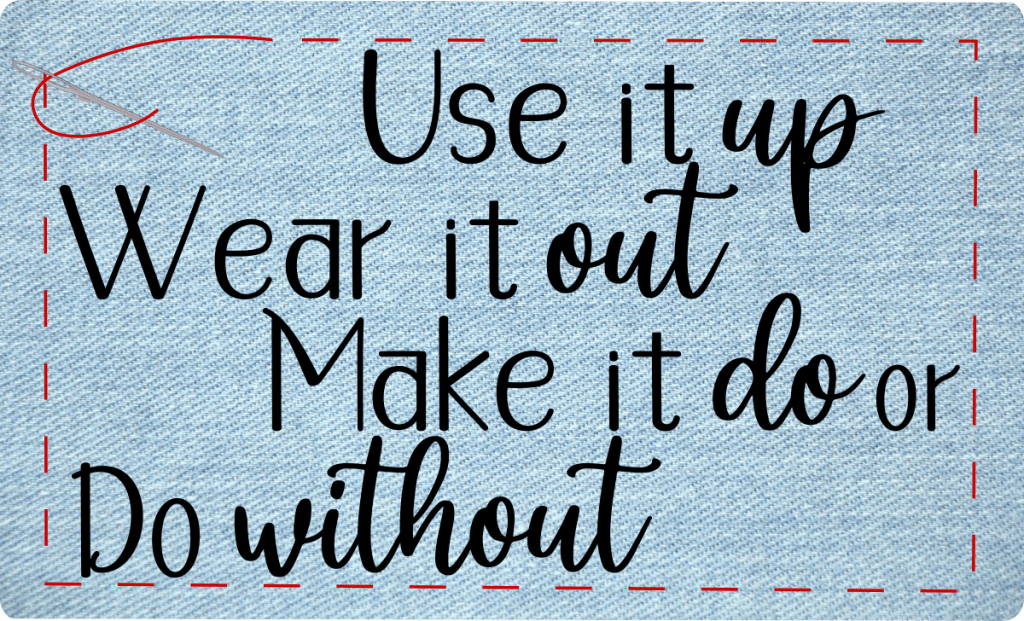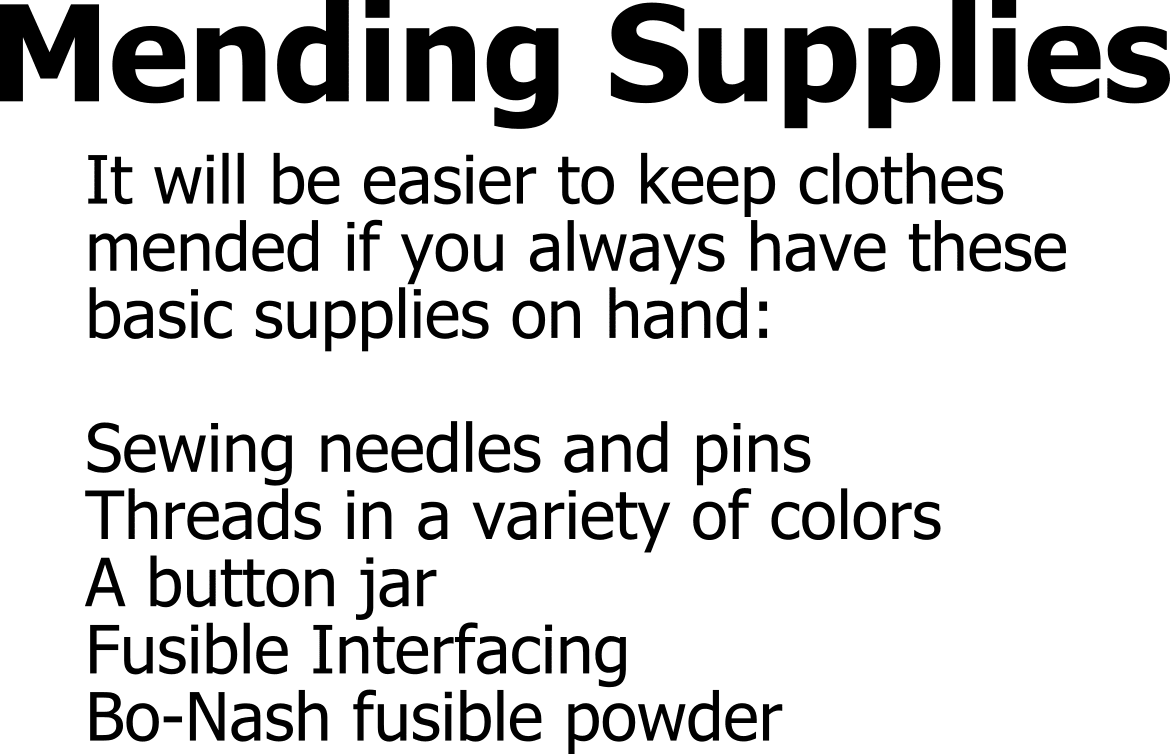

“Use it up, wear it out, make it do or do without.” This age-old proverb is a good guide for those of us trying to live a frugal and sustainable lifestyle. Unfortunately, we live in a throw-away economy. Most people just find it easier to toss things when they break or wear out, rather than try to repair or repurpose.

Clothes are a big one. Almost 10% of what Americans spend on consumable goods goes towards clothing. For the average family, that translates to about $1800.
Every year.
Just on clothes.
Mend it instead
My grandmother always had a mending basket sitting next to her rocking chair. Whenever she had a few minutes to spare or sat down to rest in the evening, she’d pick up a piece of clothing and mend it. It’s an old-fashioned idea, but maybe it’s something we should all be doing. Imagine what would happen if you were to mend torn or worn clothing instead of just tossing it. You could dramatically cut your clothing budget and decrease your environmental impact on the world.
From simple to complex
Most mending is something simple: sew on a button or re-sew a hem. Most store-bought clothing comes with one or two spare buttons attached somewhere on the inside (often at the bottom hem.) But what if the button is well and truly missing and there’s no spare? You can usually find a match at the fabric store. A packet of 4-6 buttons will usually cost $1-$2, and you’ll have extras for the next time a button disappears.
But you should also do what your grandma did: start a button jar. Before you throw away a piece of clothing or consign it to the rag bag, remove all the buttons and put them in a jar. These spare buttons will come in handy when a button falls off.
Holes and tears
It's not hard to repair a small hole or tear in a light-weight garment, and usually doesn't even require any sewing skills. The easiest thing is to repair it with a custom patch using fusible web. Fusible web is a lightweight fibrous film that has a paper backing and melts with heat. Cut the paper backing to the shape and size you need to cover the hole or tear. Then place it over another piece of fabric that closely matches the torn clothing. Following the manufacture’s instructions, press it with a hot iron. Let it cool for a minute or two and then remove the paper backing. You now have a iron-on patch that closely matches your torn clothing.
When you patch a hole, you want the patch to match the garment fabric as closely as possible. Perhaps you can cut out a little bit of the hem. If the garment has shoulder pads, that is an ideal source of matching fabric.
You don’t want the fusible part of the patch to stick to your ironing board, so lay down a piece of parchment paper underneath the hole or tear that you are mending. Pull the edges of the tear together so that they meet. Secure with pins to keep the fabric from slipping or the tear from separating. Put the patch over that and press with a hot iron. Wait a few seconds for the fabric to cool before moving it. Peel away the parchment paper if it’s sticking to the fusible web. You'll be glad it stuck to the parchment paper and not your ironing board.
You can purchase fusible web at any fabric store. Keep a yard or two on hand so that you are ready to cover any minor repair that comes along.

Darn it!
If the fabric is just a bit worn (but not actually torn) you can “darn” the worn patch. In the old days, darning was done by hand. It’s done by sewing several closely-spaced rows of running stitch and then turning the fabric 90° and sewing rows of running stitch perpendicular to the first set of stitching.
There's a really fun tool called the Speedweave darning tool. It was quite popular during wartime in the 1940s, when everyone was “making do.” It's starting to make a comeback. It allows you to make colorful and fancy darning patches. Anyone with children who wear holes in their jeans should try using this before throwing the jeans away.
But you don't need to darn by hand. If you have a sewing machine, you can still darn worn or torn fabric with a sewing machine. It's simple to do, even if you don't know how to construct clothing. It’s a lot faster and a lot sturdier than hand darning.
Simply make several parallel (or parallel-ish) stitches with your sewing machine. Go forward the length of the spot that’s worn, then stop at the end and reverse the stitching. Using the reverse button on your sewing machine, go back and forth the length of the worn patch until it’s covered. Then, with the needle down, turn the fabric 90° and stitch back and forth the width of the worn area.
Want to make it pretty?
There many ways to patch clothing so that it still nice enough to wear in public. If the tear is small and the thread is a close match, chances are the repair will be nearly invisible using Bo-Nash Fuse-It powder.
Bo-Nash is a fusible powder that let's you customize mending patches. You can use it to make invisible repairs on holes in both woven and knit fabrics, including sweater. Look for it at fabric or craft stores or online. It is an amazing tool for creating nearly invisible mends on clothing.
You can also finish off the mending by covering it with an applique, a lace insert or ribbon flowers. For young children, try covering the patch with appliques in the shape of cars, animals, flowers or tools.
Sashiko is a Japanese method that combines simple embroidery with mending to produce a pretty result you will be happy to wear in public.
Check out some of the many videos online showing you how to mend clothing using both visible and invisible techniques. With practice, these mending methods can give you stunning results while extending the life of your clothing.
It can be a challenge to find ways make your clothes last longer, mending them so that you still get good use from them. But it’s economically sensible and makes better use of earth’s resources. I hope you’ll try it.
Creative visible mending: https://www.youtube.com/watch?v=IKlKEbkbX_M
One of many videos demonstrating how to mend tears with Bo-Nash powder: https://www.youtube.com/watch?v=5BubzVnlccY
How to use the Speedweave tool: https://www.youtube.com/watch?v=qhPUjTxQgHA